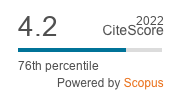Relations between snow and geomorphology in the Guadarrama Mountain: high basins of the Ventisquero de La Condesa and Valdemartín
DOI:
https://doi.org/10.18172/cig.1136Abstract
This article examines the relationship between landforms and yearly snow distribution and permanence. A study site was chosen near the source of the Manzanares River in the watersheds of two mountain streams, Condesa and Valdemartin, that converge at the lowest spot height (1,795 m, 40º 46' 32'' N and 3º 57' 15'' W) on Cabeza de Hierro Menor Peak (2,373 m, 40º 47' 56'' N and 3º 56' 10'' W). The mapping of geomorphologic units and weekly photographing of snow distribution from 1996 to 2004 provided data to map snow covered areas. ArcGis software was used with a Geographic Information System to process information and produce a map of snow permanence for the study period. The methodology also provided a means of statistically relating this map to the geomorphology, elevations, slopes and watershed orientations. The results indicate that the areas of minimum snow cover coincide with the oldest landforms. Geomorphologic activity associated with snow processes is set in motion once snow permanence exceeds the 220 days/yr threshold. In recent decades, the activity in old snow hollows ceased as the number of days of snow permanence dropped below this limit. The incisions cut by stream action and the formation of channels caused by mass movement create new areas of snow accumulation.Downloads
Download data is not yet available.
Downloads
Published
28-05-2013
How to Cite
1.
Andrés de Pablo N, Palacios Estremera D. Relations between snow and geomorphology in the Guadarrama Mountain: high basins of the Ventisquero de La Condesa and Valdemartín. CIG [Internet]. 2013 May 28 [cited 2024 Apr. 25];30:85-116. Available from: https://publicaciones.unirioja.es/ojs/index.php/cig/article/view/1136
Issue
Section
Articles
License
The authors retain copyright of articles and authorize Cuadernos de Investigación Geográfica / Geographical Research Letters the first publication. They are free to share and redistribute the article without obtaining permission from the publisher as long as they give appropriate credit to the editor and the journal.
Self-archiving is allowed too. In fact, it is recommendable to deposit a PDF version of the paper in academic and/or institutional repositories.
It is recommended to include the DOI number.
This journal is licensed under a Creative Commons Attribution 4.0 International License











